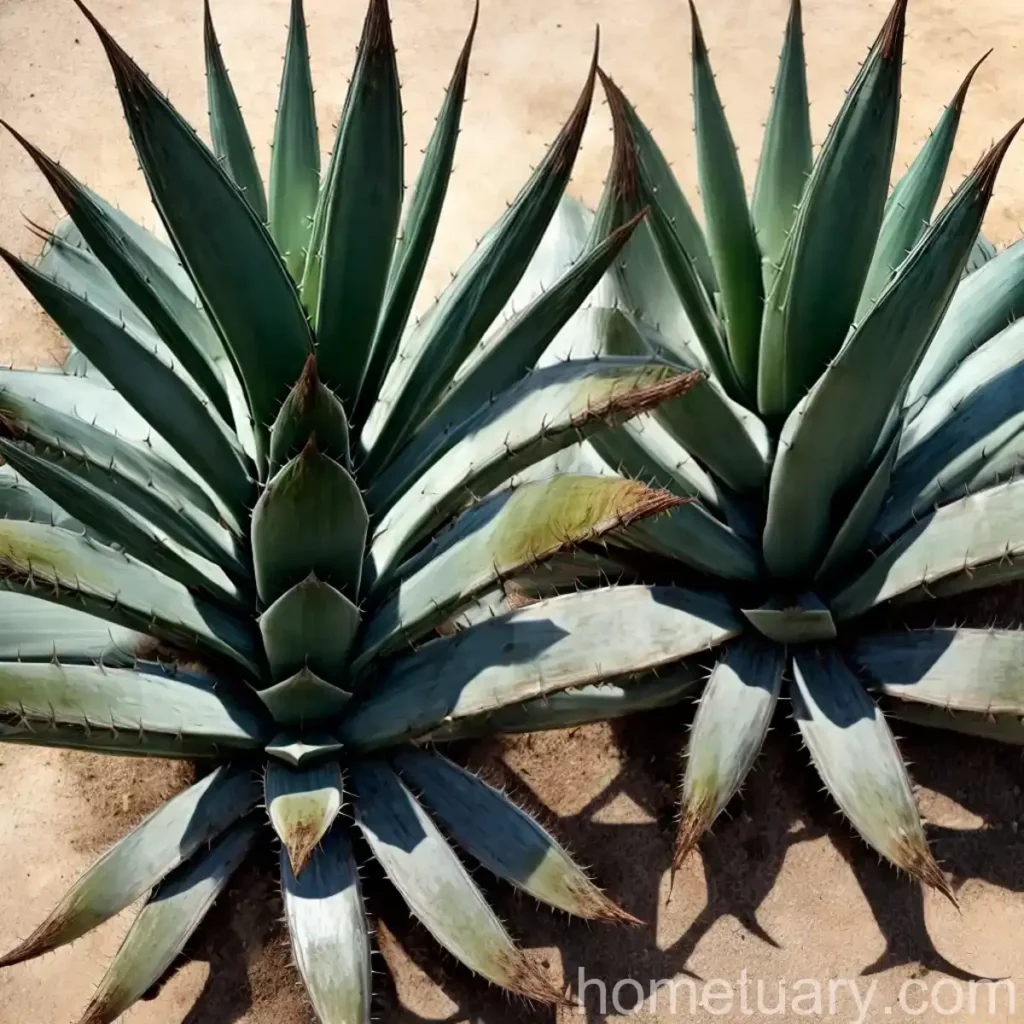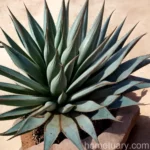The Century Plant (Agave victoriae-reginae): A Complete Guide
Plants have always captured the fascination of human beings with their diverse and captivating features. Among the myriad of plants that grace our planet, the century plant, scientifically known as Agave victoriae-reginae, stands out for its striking appearance and versatility. This comprehensive guide delves into the various aspects of the century plant, from its cultural and medicinal uses to its unique characteristics and maintenance requirements. Whether you are a novice gardener or an experienced botanist, this article aims to provide you with valuable insights into the world of Agave victoriae-reginae.
What is the Century Plant (Agave victoriae-reginae)?
The century plant, Agave victoriae-reginae, is a visually striking succulent that belongs to the Agave genus. This plant species is native to the Chihuahuan desert regions of Mexico. It is renowned for its compact rosette of stiff, dark-green leaves adorned with eye-catching white markings. The unique arrangement of spiky ridges along the leaves’ margins further enhances its ornamental appeal. The century plant earns its common name from the misconception that it takes a century to bloom, although it typically flowers after 10 to 25 years, depending on environmental conditions.
Key Takeaways – Century Plant (Agave victoriae-reginae)
Before delving into the specifics of caring for the century plant, it is essential to understand some key takeaways about this remarkable species. Here are some important points to consider:
- The century plant, Agave victoriae-reginae, is a striking succulent known for its visually appealing rosette of dark-green leaves with white markings.
- It is native to the Chihuahuan desert regions of Mexico and is recognized for its drought-resistant and low-maintenance characteristics.
- The misconception that it takes a century to flower has led to its common name, the century plant, although it typically blooms after 10 to 25 years.
With these key takeaways in mind, let’s explore the various facets of the century plant, from its cultural significance to its maintenance requirements.
Culture
The cultural significance of the century plant, Agave victoriae-reginae, extends beyond its ornamental value. Culturally, this plant holds a revered status in the folklore and traditions of the indigenous communities of Mexico. It is often associated with symbols of resilience, endurance, and the arid beauty of the desert landscape. Agave plants, including Agave victoriae-reginae, have been utilized for various purposes, ranging from food and medicine to the production of traditional beverages like pulque and tequila.
Uses
Ornamental Value
As a landscaping and decorative plant, the century plant holds immense value due to its striking visual appeal and low maintenance requirements. Its compact rosette shape and architectural foliage make it an ideal choice for xeriscaping, rock gardens, and arid landscape designs. Additionally, it can be grown in containers, adding a touch of elegance to both indoor and outdoor settings.
Medicinal and Industrial Uses
In traditional medicine, various parts of the Agave plant have been utilized for their medicinal properties. For instance, Agave nectar, derived from the sap of certain Agave species, is used as a natural sweetener and is considered a healthier alternative to processed sugars. Furthermore, the fibers extracted from Agave leaves have been historically employed for the production of textiles and ropes.
Culinary Applications
The century plant has also found its way into culinary practices, particularly in the production of alcoholic beverages such as tequila. The fermented and distilled juices extracted from the core of the plant, known as “piñas,” serve as the foundation for the production of tequila, a renowned Mexican spirit with global appeal.
Water
Agave victoriae-reginae is renowned for its exceptional drought-resistant capabilities, making it well-adapted to arid environments. When it comes to watering this plant, it is crucial to exercise restraint, as excessive moisture can lead to root rot and other complications. A well-draining soil mix and periodic, deep watering during the growing season are typically sufficient to sustain the century plant. During the winter months or periods of dormancy, water should be sparingly administered to prevent waterlogged conditions.
Sunlight
In its natural habitat, the century plant thrives in full sun exposure, basking in the intense rays of the desert sun. When cultivated in a garden or container, it is essential to provide adequate sunlight to ensure the plant’s optimal growth and development. A minimum of 6 hours of direct sunlight per day is recommended to maintain the plant’s vibrant foliage and overall health.
Fertilizer
The century plant, Agave victoriae-reginae, exhibits minimal fertilizer requirements, owing to its natural adaptations to nutrient-deficient environments. However, a balanced, low-nitrogen fertilizer can be applied sparingly during the growing season to support the plant’s vitality. It is advisable to dilute the fertilizer to half-strength and administer it once or twice during the spring and summer months.
Soil
The soil requirements for Agave victoriae-reginae are centered around well-draining, sandy or loamy soils that mimic the arid conditions of its native habitat. A blend of cactus mix and perlite can offer the ideal substrate for promoting root aeration and preventing water stagnation. Additionally, the slightly alkaline nature of the soil is conducive to the century plant’s growth, ensuring optimal nutrient uptake and overall health.
Pruning
The century plant, characterized by its symmetrical rosette of leaves, typically does not necessitate extensive pruning. However, it is essential to regularly remove any dead or damaged leaves to maintain the plant’s aesthetic appeal and prevent potential disease spread. Pruning activities should be performed cautiously, considering the sharp spines and rigid structure of the leaves.
Propagation
Offsets
Agave victoriae-reginae can be propagated through the division of offsets, also known as “pups,” that develop around the base of the mature plant. These offsets can be carefully separated from the parent plant and transplanted into individual containers or directly into the garden. This method of propagation allows for the production of genetically identical clones of the parent plant.
Seed Propagation
While less commonly employed due to the slow growth rate and variability in offspring, Agave victoriae-reginae can also be propagated from seeds. The seeds should be sown in well-draining soil mix and kept consistently moist until germination occurs. Since seed propagation introduces genetic diversity, it may result in variations in the characteristics of the offspring.
Container Popularity
The century plant, Agave victoriae-reginae, is a popular choice for container gardening due to its compact size, ornamental foliage, and low maintenance requirements. It can thrive in various container sizes, making it suitable for both indoor and outdoor settings. When cultivating Agave victoriae-reginae in containers, it is imperative to select pots with adequate drainage holes to prevent waterlogging.
Container Common Diseases
In container cultivation, the century plant may be susceptible to certain diseases and issues associated with suboptimal growing conditions. Some common diseases that can affect Agave victoriae-reginae in containers include:
-
Root Rot: Excessive moisture and poor drainage can lead to the development of root rot, characterized by the decay of the plant’s root system. This condition can manifest as wilting, yellowing, and eventual collapse of the plant.
-
Powdery Mildew: Under humid and stagnant conditions, the development of powdery mildew on the leaves of the century plant can occur, leading to the formation of a white, powdery fungal growth.
-
Mealybugs and Scale Insects: These sap-sucking pests can infest Agave victoriae-reginae in containers, causing damage to the foliage and potential decline in plant health.
Disease Diagnosis
Proper diagnosis of diseases affecting the century plant is essential for implementing targeted management strategies. When observing signs of disease or distress in Agave victoriae-reginae, careful inspection of the plant and its growing conditions is necessary. Specific symptoms, such as wilting, discoloration, and abnormal growth, can provide valuable clues regarding the root cause of the issue.
Common Pests
Agave victoriae-reginae, like other members of the Agave genus, may encounter certain pests that can compromise its health and vigor. Some common pests that may affect the century plant include:
-
Aphids: These small, sap-feeding insects can congregate on the undersides of the leaves, causing distortion and yellowing of the foliage.
-
Spider Mites: These minuscule arachnids can inflict damage to the century plant by feeding on the plant’s sap, resulting in stippled, discolored leaves.
-
Snout Weevils: The larvae of snout weevils can bore into the core of the century plant, causing structural damage and weakening the plant’s vitality.
Proactive measures, such as regular inspections and the implementation of integrated pest management practices, can aid in preventing and managing pest infestations effectively.
Botanist’s Tips
To ensure the optimal growth and well-being of the century plant, here are some valuable tips for botanists and plant enthusiasts:
-
Provide well-draining soil mix: Utilize a cactus mix blended with perlite to promote proper drainage and prevent waterlogging.
-
Monitor sunlight exposure: Ensure that the century plant receives sufficient direct sunlight, especially when cultivated indoors.
-
Practice restraint in watering: Adhere to a watering routine that avoids excess moisture while ensuring adequate hydration during the growing season.
-
Inspect for pests and diseases: Regularly inspect the plant for signs of pests and diseases, taking prompt action if any issues are detected.
-
Exercise caution when pruning: Approach pruning activities with care, considering the sharp spines and rigid structure of the century plant’s leaves.
Fun Facts
As we continue unraveling the captivating world of the century plant, here are some fun and intriguing facts about Agave victoriae-reginae:
-
Agave victoriae-reginae is also referred to as the “Queen Victoria Agave,” an homage to its stately and regal appearance.
-
The intricate white markings on the dark-green leaves of the century plant contribute to its mesmerizing and artistic allure, making it a prized addition to garden landscapes.
-
Despite its common name, the century plant’s characteristic bloom typically occurs after 10 to 25 years, rather than a century, adding a sense of anticipation to its flowering cycle.
-
Agave victoriae-reginae has been a subject of fascination for artists, photographers, and botanical enthusiasts, inspiring creative interpretations and depictions of its striking form.
Now that we have delved into the various aspects of Agave victoriae-reginae, from its cultural significance to its maintenance requirements, let’s explore some external resources for further exploration and research.
Links to External Resources
- The Agave Page – Dave’s Garden
- Agave victoriae-reginae – Missouri Botanical Garden
- Agave victoriae-reginae – Royal Horticultural Society
These resources offer valuable insights, visual references, and expert guidance on the cultivation and appreciation of Agave victoriae-reginae, allowing for a deeper exploration of the fascinating world of this remarkable succulent.
As we conclude this comprehensive guide to the century plant, Agave victoriae-reginae, it is evident that this species encompasses a rich tapestry of cultural, ornamental, and practical significance. Whether adorning arid landscapes, serving as a source of traditional materials, or captivating the imagination with its mesmerizing form, the century plant continues to enthrall plant enthusiasts and botanists alike. By understanding its unique characteristics and care requirements, we can cultivate a deeper appreciation for the enduring allure of Agave victoriae-reginae.
In the arid expanses of the desert and the curated spaces of botanical gardens, the century plant stands as a testament to resilience, longevity, and natural elegance—a living embodiment of the timeless beauty of the plant kingdom.















